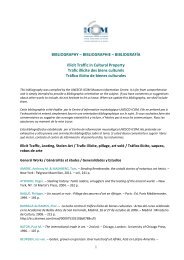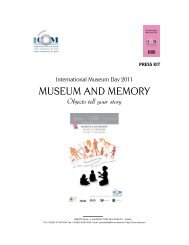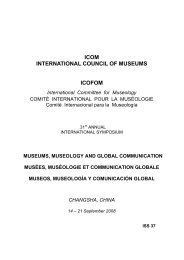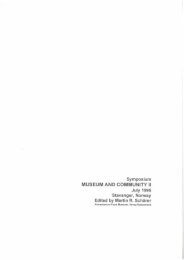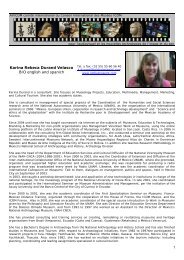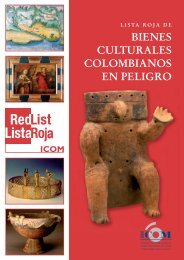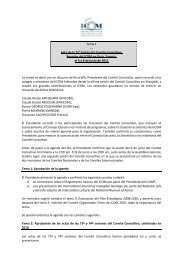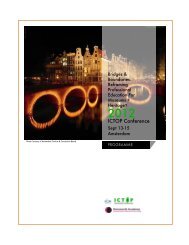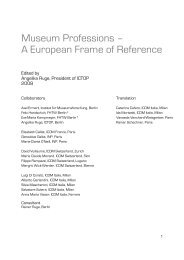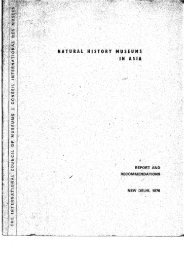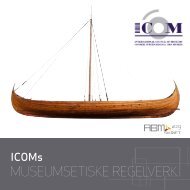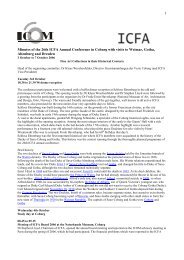Key Concepts of Museology - ICOM
Key Concepts of Museology - ICOM
Key Concepts of Museology - ICOM
You also want an ePaper? Increase the reach of your titles
YUMPU automatically turns print PDFs into web optimized ePapers that Google loves.
tion and how to inventorize museum<br />
objects. They create the scenario for<br />
the contents and propose a form <strong>of</strong><br />
language which includes additional<br />
media to aid understanding. They<br />
are concerned with the needs <strong>of</strong><br />
the public and employ the communication<br />
methods most suitable for<br />
putting across the message <strong>of</strong> the<br />
exhibition. Their role, <strong>of</strong>ten as the<br />
head <strong>of</strong> a project, is to coordinate<br />
all the scientifi c and technical specialists<br />
working within a museum:<br />
organising them, sometimes clashing<br />
with them and arbitrating. Other<br />
specifi c posts have been created to<br />
fulfi l these tasks: the management<br />
<strong>of</strong> the art works or objects is left to<br />
the registrars, the head <strong>of</strong> security is<br />
responsible for surveillance and the<br />
tasks carried out by this department,<br />
the conservator is a specialist in preventive<br />
conservation and in remedial<br />
conservation measures, and even<br />
restoration. It is in this context, and<br />
in interrelation with the different<br />
departments, that museographers<br />
concern themselves with the exhibition<br />
tasks. Museography is distinct<br />
from scenography (exhibition or<br />
stage design), which is understood to<br />
mean all the techniques required for<br />
installing and fi tting out display spaces,<br />
just as it is different from interior<br />
design. Certainly stage design<br />
and museum interior design are a<br />
part <strong>of</strong> museography, which brings<br />
museums closer to other methods<br />
<strong>of</strong> visualisation, but other elements<br />
must also be taken into account such<br />
as the public, its understanding <strong>of</strong><br />
the message, and the preservation<br />
<strong>of</strong> heritage. These aspects make<br />
museographers (or exhibition specialists)<br />
the intermediary between<br />
the collections curator, the architect<br />
and the public. Their role varies,<br />
however, depending whether or not<br />
the museum or the exhibition site<br />
has a curator to lead the project.<br />
The further development <strong>of</strong> the role<br />
<strong>of</strong> some specialists within museums<br />
(architects, artists, exhibition curators,<br />
etc.) has led to a constant fi netuning<br />
<strong>of</strong> the museogapher’s role as<br />
intermediary.<br />
3. Formerly and through its etymology,<br />
museography referred to<br />
the description <strong>of</strong> the contents <strong>of</strong><br />
a museum. Just as a bibliography<br />
is one <strong>of</strong> the fundamental stages <strong>of</strong><br />
scientifi c research, museography<br />
was devised as a way to facilitate the<br />
search for documentary sources <strong>of</strong><br />
objects in order to develop their systematic<br />
study. This meaning endured<br />
throughout the 19 th century and still<br />
continues today in some languages,<br />
in particular Russian.<br />
DERIVATIVES: MUSEOGRAPHER, MUSEOGRAPHIC.<br />
CORRELATED: EXHIBITION DESIGN, EXHIBITION<br />
PRACTICE, INTERIOR DESIGN, MUSEUM FUNCTIONS,<br />
MUSEUM OPERATIONS, MUSEUM PRACTICE.<br />
MUSEOLOGY<br />
(MUSEUM STUDIES)<br />
n. – Equivalent in French: muséologie; Spanish:<br />
museología; German: Museologie,<br />
Museumswissenschaft, Museumskunde; Italian:<br />
museologia; Portuguese: museologia.<br />
53



